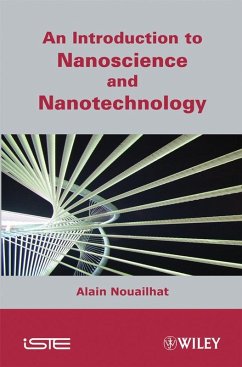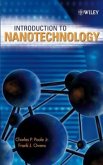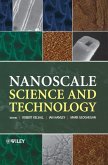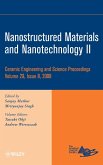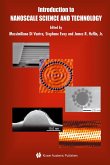Alain Nouailhat
An Introduction to Nanoscience and Nanotechnology
Alain Nouailhat
An Introduction to Nanoscience and Nanotechnology
- Gebundenes Buch
- Merkliste
- Auf die Merkliste
- Bewerten Bewerten
- Teilen
- Produkt teilen
- Produkterinnerung
- Produkterinnerung
This book recalls the basics required for an understanding of the nanoworld (quantum physics, molecular biology, micro and nanoelectronics) and gives examples of applications in various fields: materials, energy, devices, data management and life sciences. It is clearly shown how the nanoworld is at the crossing point of knowledge and innovation. Written by an expert who spent a large part of his professional life in the field, the title also gives a general insight into the evolution of nanosciences and nanotechnologies. The reader is thus provided with an introduction to this complex area…mehr
Andere Kunden interessierten sich auch für
![Introduction to Nanotechnology Introduction to Nanotechnology]() Poole, Jr., Charles P.Introduction to Nanotechnology173,99 €
Poole, Jr., Charles P.Introduction to Nanotechnology173,99 €![Nanoscience and the Environment Nanoscience and the Environment]() Nanoscience and the Environment203,99 €
Nanoscience and the Environment203,99 €![Nanoscale Science and Technology Nanoscale Science and Technology]() Nanoscale Science and Technology122,99 €
Nanoscale Science and Technology122,99 €![Nanostructured Materials and Nanotechnology II, Volume 29, Issue 8 Nanostructured Materials and Nanotechnology II, Volume 29, Issue 8]() Nanostructured Materials and Nanotechnology II, Volume 29, Issue 8122,99 €
Nanostructured Materials and Nanotechnology II, Volume 29, Issue 8122,99 €![Nanosolids Nanosolids]() Frank J. OwensNanosolids140,99 €
Frank J. OwensNanosolids140,99 €![Introduction to Nanoscale Science and Technology Introduction to Nanoscale Science and Technology]() Massimiliano Di Ventra / Stephane Evoy / James R. Heflin Jr. (eds.)Introduction to Nanoscale Science and Technology109,99 €
Massimiliano Di Ventra / Stephane Evoy / James R. Heflin Jr. (eds.)Introduction to Nanoscale Science and Technology109,99 €![Introduction to Maintenance Engineering Introduction to Maintenance Engineering]() Mohamed Ben-DayaIntroduction to Maintenance Engineering113,99 €
Mohamed Ben-DayaIntroduction to Maintenance Engineering113,99 €-
-
-
This book recalls the basics required for an understanding of the nanoworld (quantum physics, molecular biology, micro and nanoelectronics) and gives examples of applications in various fields: materials, energy, devices, data management and life sciences. It is clearly shown how the nanoworld is at the crossing point of knowledge and innovation. Written by an expert who spent a large part of his professional life in the field, the title also gives a general insight into the evolution of nanosciences and nanotechnologies. The reader is thus provided with an introduction to this complex area with different "tracks" for further personal comprehension and reflection. This guided and illustrated tour also reveals the importance of the nanoworld in everyday life.
Hinweis: Dieser Artikel kann nur an eine deutsche Lieferadresse ausgeliefert werden.
Hinweis: Dieser Artikel kann nur an eine deutsche Lieferadresse ausgeliefert werden.
Produktdetails
- Produktdetails
- Verlag: Wiley
- Seitenzahl: 256
- Erscheinungstermin: 1. Februar 2008
- Englisch
- Abmessung: 235mm x 163mm x 19mm
- Gewicht: 499g
- ISBN-13: 9781848210073
- ISBN-10: 1848210078
- Artikelnr.: 23433831
- Herstellerkennzeichnung
- Libri GmbH
- Europaallee 1
- 36244 Bad Hersfeld
- gpsr@libri.de
- Verlag: Wiley
- Seitenzahl: 256
- Erscheinungstermin: 1. Februar 2008
- Englisch
- Abmessung: 235mm x 163mm x 19mm
- Gewicht: 499g
- ISBN-13: 9781848210073
- ISBN-10: 1848210078
- Artikelnr.: 23433831
- Herstellerkennzeichnung
- Libri GmbH
- Europaallee 1
- 36244 Bad Hersfeld
- gpsr@libri.de
Alain Nouailhat is Director of Research at the CNRS, Paris, France.
Foreword xiii
Acknowledgements xv
Preface xvii
Chapter 1. What are Nanos? 1
1.1. What are we talking about? 3
1.2. References 7
1.2.1. Two basic facts 7
1.2.2. Two approaches 9
1.2.3. Two key points 11
1.3. Some bonus material for economists 13
Chapter 2. Some Science to Get You Started 15
2.1. Quantum physics 17
2.1.1. From the traditional world to the quantum world 17
2.1.2. Two fundamental concepts 19
2.1.2.1. Wave-corpuscle duality 19
2.1.2.2. Probability in the quantum world 21
2.2. The key players 22
2.2.1. The electron 22
2.2.1.1. The cornerstone of matter 22
2.2.1.2. Electronic states 23
2.2.1.3. The quantification of energy 24
2.2.1.4. Bonds 25
2.2.2. The photon 27
2.2.2.1. The wave 27
2.2.2.2. The energy grain 30
2.3. Molecules 34
2.3.1. From the smallest molecule to the largest and their spectacular
properties 34
2.3.2. Functionality 35
2.4. Solid matter 36
2.4.1. Insulators or conductors. 36
2.4.2. Semi-conductors 37
2.4.2.1. Silicon crystal 37
2.4.2.2 Electrons and holes 40
2.4.2.3 Junctions 40
2.4.3. Nanomaterials 41
2.5. Quantum boxes: between the atom and the crystal 41
2.6. Some bonus material for physicists 42
2.6.1 Luminescence 42
2.6.2. The laser device 44
Chapter 3. The Revolution in Techniques Used in Observation and Imagery 51
3.1. Observing with photons 53
3.1.1. The optical microscope in visible light 53
3.1.2. X-ray machines 54
3.2. Observing with electrons 55
3.2.1. The transmission electron microscope (TEM) 55
3.2.2. The scanning electron microscope (SEM) 56
3.3. Touching the atoms 58
3.4. Observing how our brain functions 60
3.4.1. Nuclear magnetic resonance 60
3.4.2. Functional magnetic resonance imaging 61
3.5. Some bonus material for researchers 62
Chapter 4. The Marriage of Software and Hardware 69
4.1. Small is beautiful 71
4.2. Miniaturization 71
4.3. Integration 72
4.3.1. The silicon planet 72
4.3.2. An expanding universe 78
4.4. Programs 82
4.5. Some bonus material for mathematicians 83
Chapter 5. Mechanics of the Living World 89
5.1. Proteins - molecules with exceptional properties 93
5.1.1. The program of cellular production 94
5.1.2. Reading instructions and the production of proteins 95
5.1.3. How does it work? 99
5.1.4. Molecular disfunctioning 100
5.1.4.1. External causes 100
5.1.4.2. Internal causes 100
5.2. Intervention of human beings 101
5.2.1. Medication 102
5.2.2. The creation of those famous GMOs (Genetically Modified Organisms)
102
5.2.3. Manipulation of embryos 103
5.3. Some bonus material for biologists 103
Chapter 6. The Uses of Nanotechnologies 107
6.1. New objects 109
6.1.1. Carbon in all its states 109
6.1.1.1. Nanodiamonds 110
6.1.1.2. Carbon nanotubes 110
6.1.2. A handful of gold atoms 116
6.2. Ground-breaking products 116
6.2.1. Surface treatment 117
6.2.2. Incorporation in a composite environment 119
6.3. From micro to nanosystems 120
6.3.1. Miniature components - MEMS 120
6.3.1.1. A print head for inkjet printers 120
6.3.1.2. Airbags 122
6.3.1.3. A microlens for miniaturized optics 123
6.3.1.4. Magnetic disk readheads: quantum nanostructures 124
6.3.2. Microsources of energy: key points for embedded systems 124
6.3.3. Micromotors 125
6.4. A global integration 132
6.5. Some bonus material for engineers 139
Chapter 7. Nanos are Changing the World 143
7.1. A simulation or a virtual world 145
7.2. Understanding nature 151
7.2.1. Understanding energy 151
7.2.2. Understanding materials 152
7.2.3. Understanding information 154
7.2.4. Understanding life 156
7.3. Watch out for nanomedicine 159
7.4. Nanosciences and our future 161
7.5. Essential ethics 165
7.6. Conclusion 169
Appendices 173
Appendix A. European Parliament Resolution on Nanosciences and
Nanotechnologies 175
Appendix B. Eight Guidelines on Nanotechnologies Issued by the CNRS Ethics
Committee 185
Abbreviations 191
Bibliography 195
Figures 197
Index 205
Acknowledgements xv
Preface xvii
Chapter 1. What are Nanos? 1
1.1. What are we talking about? 3
1.2. References 7
1.2.1. Two basic facts 7
1.2.2. Two approaches 9
1.2.3. Two key points 11
1.3. Some bonus material for economists 13
Chapter 2. Some Science to Get You Started 15
2.1. Quantum physics 17
2.1.1. From the traditional world to the quantum world 17
2.1.2. Two fundamental concepts 19
2.1.2.1. Wave-corpuscle duality 19
2.1.2.2. Probability in the quantum world 21
2.2. The key players 22
2.2.1. The electron 22
2.2.1.1. The cornerstone of matter 22
2.2.1.2. Electronic states 23
2.2.1.3. The quantification of energy 24
2.2.1.4. Bonds 25
2.2.2. The photon 27
2.2.2.1. The wave 27
2.2.2.2. The energy grain 30
2.3. Molecules 34
2.3.1. From the smallest molecule to the largest and their spectacular
properties 34
2.3.2. Functionality 35
2.4. Solid matter 36
2.4.1. Insulators or conductors. 36
2.4.2. Semi-conductors 37
2.4.2.1. Silicon crystal 37
2.4.2.2 Electrons and holes 40
2.4.2.3 Junctions 40
2.4.3. Nanomaterials 41
2.5. Quantum boxes: between the atom and the crystal 41
2.6. Some bonus material for physicists 42
2.6.1 Luminescence 42
2.6.2. The laser device 44
Chapter 3. The Revolution in Techniques Used in Observation and Imagery 51
3.1. Observing with photons 53
3.1.1. The optical microscope in visible light 53
3.1.2. X-ray machines 54
3.2. Observing with electrons 55
3.2.1. The transmission electron microscope (TEM) 55
3.2.2. The scanning electron microscope (SEM) 56
3.3. Touching the atoms 58
3.4. Observing how our brain functions 60
3.4.1. Nuclear magnetic resonance 60
3.4.2. Functional magnetic resonance imaging 61
3.5. Some bonus material for researchers 62
Chapter 4. The Marriage of Software and Hardware 69
4.1. Small is beautiful 71
4.2. Miniaturization 71
4.3. Integration 72
4.3.1. The silicon planet 72
4.3.2. An expanding universe 78
4.4. Programs 82
4.5. Some bonus material for mathematicians 83
Chapter 5. Mechanics of the Living World 89
5.1. Proteins - molecules with exceptional properties 93
5.1.1. The program of cellular production 94
5.1.2. Reading instructions and the production of proteins 95
5.1.3. How does it work? 99
5.1.4. Molecular disfunctioning 100
5.1.4.1. External causes 100
5.1.4.2. Internal causes 100
5.2. Intervention of human beings 101
5.2.1. Medication 102
5.2.2. The creation of those famous GMOs (Genetically Modified Organisms)
102
5.2.3. Manipulation of embryos 103
5.3. Some bonus material for biologists 103
Chapter 6. The Uses of Nanotechnologies 107
6.1. New objects 109
6.1.1. Carbon in all its states 109
6.1.1.1. Nanodiamonds 110
6.1.1.2. Carbon nanotubes 110
6.1.2. A handful of gold atoms 116
6.2. Ground-breaking products 116
6.2.1. Surface treatment 117
6.2.2. Incorporation in a composite environment 119
6.3. From micro to nanosystems 120
6.3.1. Miniature components - MEMS 120
6.3.1.1. A print head for inkjet printers 120
6.3.1.2. Airbags 122
6.3.1.3. A microlens for miniaturized optics 123
6.3.1.4. Magnetic disk readheads: quantum nanostructures 124
6.3.2. Microsources of energy: key points for embedded systems 124
6.3.3. Micromotors 125
6.4. A global integration 132
6.5. Some bonus material for engineers 139
Chapter 7. Nanos are Changing the World 143
7.1. A simulation or a virtual world 145
7.2. Understanding nature 151
7.2.1. Understanding energy 151
7.2.2. Understanding materials 152
7.2.3. Understanding information 154
7.2.4. Understanding life 156
7.3. Watch out for nanomedicine 159
7.4. Nanosciences and our future 161
7.5. Essential ethics 165
7.6. Conclusion 169
Appendices 173
Appendix A. European Parliament Resolution on Nanosciences and
Nanotechnologies 175
Appendix B. Eight Guidelines on Nanotechnologies Issued by the CNRS Ethics
Committee 185
Abbreviations 191
Bibliography 195
Figures 197
Index 205
Foreword xiii
Acknowledgements xv
Preface xvii
Chapter 1. What are Nanos? 1
1.1. What are we talking about? 3
1.2. References 7
1.2.1. Two basic facts 7
1.2.2. Two approaches 9
1.2.3. Two key points 11
1.3. Some bonus material for economists 13
Chapter 2. Some Science to Get You Started 15
2.1. Quantum physics 17
2.1.1. From the traditional world to the quantum world 17
2.1.2. Two fundamental concepts 19
2.1.2.1. Wave-corpuscle duality 19
2.1.2.2. Probability in the quantum world 21
2.2. The key players 22
2.2.1. The electron 22
2.2.1.1. The cornerstone of matter 22
2.2.1.2. Electronic states 23
2.2.1.3. The quantification of energy 24
2.2.1.4. Bonds 25
2.2.2. The photon 27
2.2.2.1. The wave 27
2.2.2.2. The energy grain 30
2.3. Molecules 34
2.3.1. From the smallest molecule to the largest and their spectacular
properties 34
2.3.2. Functionality 35
2.4. Solid matter 36
2.4.1. Insulators or conductors. 36
2.4.2. Semi-conductors 37
2.4.2.1. Silicon crystal 37
2.4.2.2 Electrons and holes 40
2.4.2.3 Junctions 40
2.4.3. Nanomaterials 41
2.5. Quantum boxes: between the atom and the crystal 41
2.6. Some bonus material for physicists 42
2.6.1 Luminescence 42
2.6.2. The laser device 44
Chapter 3. The Revolution in Techniques Used in Observation and Imagery 51
3.1. Observing with photons 53
3.1.1. The optical microscope in visible light 53
3.1.2. X-ray machines 54
3.2. Observing with electrons 55
3.2.1. The transmission electron microscope (TEM) 55
3.2.2. The scanning electron microscope (SEM) 56
3.3. Touching the atoms 58
3.4. Observing how our brain functions 60
3.4.1. Nuclear magnetic resonance 60
3.4.2. Functional magnetic resonance imaging 61
3.5. Some bonus material for researchers 62
Chapter 4. The Marriage of Software and Hardware 69
4.1. Small is beautiful 71
4.2. Miniaturization 71
4.3. Integration 72
4.3.1. The silicon planet 72
4.3.2. An expanding universe 78
4.4. Programs 82
4.5. Some bonus material for mathematicians 83
Chapter 5. Mechanics of the Living World 89
5.1. Proteins - molecules with exceptional properties 93
5.1.1. The program of cellular production 94
5.1.2. Reading instructions and the production of proteins 95
5.1.3. How does it work? 99
5.1.4. Molecular disfunctioning 100
5.1.4.1. External causes 100
5.1.4.2. Internal causes 100
5.2. Intervention of human beings 101
5.2.1. Medication 102
5.2.2. The creation of those famous GMOs (Genetically Modified Organisms)
102
5.2.3. Manipulation of embryos 103
5.3. Some bonus material for biologists 103
Chapter 6. The Uses of Nanotechnologies 107
6.1. New objects 109
6.1.1. Carbon in all its states 109
6.1.1.1. Nanodiamonds 110
6.1.1.2. Carbon nanotubes 110
6.1.2. A handful of gold atoms 116
6.2. Ground-breaking products 116
6.2.1. Surface treatment 117
6.2.2. Incorporation in a composite environment 119
6.3. From micro to nanosystems 120
6.3.1. Miniature components - MEMS 120
6.3.1.1. A print head for inkjet printers 120
6.3.1.2. Airbags 122
6.3.1.3. A microlens for miniaturized optics 123
6.3.1.4. Magnetic disk readheads: quantum nanostructures 124
6.3.2. Microsources of energy: key points for embedded systems 124
6.3.3. Micromotors 125
6.4. A global integration 132
6.5. Some bonus material for engineers 139
Chapter 7. Nanos are Changing the World 143
7.1. A simulation or a virtual world 145
7.2. Understanding nature 151
7.2.1. Understanding energy 151
7.2.2. Understanding materials 152
7.2.3. Understanding information 154
7.2.4. Understanding life 156
7.3. Watch out for nanomedicine 159
7.4. Nanosciences and our future 161
7.5. Essential ethics 165
7.6. Conclusion 169
Appendices 173
Appendix A. European Parliament Resolution on Nanosciences and
Nanotechnologies 175
Appendix B. Eight Guidelines on Nanotechnologies Issued by the CNRS Ethics
Committee 185
Abbreviations 191
Bibliography 195
Figures 197
Index 205
Acknowledgements xv
Preface xvii
Chapter 1. What are Nanos? 1
1.1. What are we talking about? 3
1.2. References 7
1.2.1. Two basic facts 7
1.2.2. Two approaches 9
1.2.3. Two key points 11
1.3. Some bonus material for economists 13
Chapter 2. Some Science to Get You Started 15
2.1. Quantum physics 17
2.1.1. From the traditional world to the quantum world 17
2.1.2. Two fundamental concepts 19
2.1.2.1. Wave-corpuscle duality 19
2.1.2.2. Probability in the quantum world 21
2.2. The key players 22
2.2.1. The electron 22
2.2.1.1. The cornerstone of matter 22
2.2.1.2. Electronic states 23
2.2.1.3. The quantification of energy 24
2.2.1.4. Bonds 25
2.2.2. The photon 27
2.2.2.1. The wave 27
2.2.2.2. The energy grain 30
2.3. Molecules 34
2.3.1. From the smallest molecule to the largest and their spectacular
properties 34
2.3.2. Functionality 35
2.4. Solid matter 36
2.4.1. Insulators or conductors. 36
2.4.2. Semi-conductors 37
2.4.2.1. Silicon crystal 37
2.4.2.2 Electrons and holes 40
2.4.2.3 Junctions 40
2.4.3. Nanomaterials 41
2.5. Quantum boxes: between the atom and the crystal 41
2.6. Some bonus material for physicists 42
2.6.1 Luminescence 42
2.6.2. The laser device 44
Chapter 3. The Revolution in Techniques Used in Observation and Imagery 51
3.1. Observing with photons 53
3.1.1. The optical microscope in visible light 53
3.1.2. X-ray machines 54
3.2. Observing with electrons 55
3.2.1. The transmission electron microscope (TEM) 55
3.2.2. The scanning electron microscope (SEM) 56
3.3. Touching the atoms 58
3.4. Observing how our brain functions 60
3.4.1. Nuclear magnetic resonance 60
3.4.2. Functional magnetic resonance imaging 61
3.5. Some bonus material for researchers 62
Chapter 4. The Marriage of Software and Hardware 69
4.1. Small is beautiful 71
4.2. Miniaturization 71
4.3. Integration 72
4.3.1. The silicon planet 72
4.3.2. An expanding universe 78
4.4. Programs 82
4.5. Some bonus material for mathematicians 83
Chapter 5. Mechanics of the Living World 89
5.1. Proteins - molecules with exceptional properties 93
5.1.1. The program of cellular production 94
5.1.2. Reading instructions and the production of proteins 95
5.1.3. How does it work? 99
5.1.4. Molecular disfunctioning 100
5.1.4.1. External causes 100
5.1.4.2. Internal causes 100
5.2. Intervention of human beings 101
5.2.1. Medication 102
5.2.2. The creation of those famous GMOs (Genetically Modified Organisms)
102
5.2.3. Manipulation of embryos 103
5.3. Some bonus material for biologists 103
Chapter 6. The Uses of Nanotechnologies 107
6.1. New objects 109
6.1.1. Carbon in all its states 109
6.1.1.1. Nanodiamonds 110
6.1.1.2. Carbon nanotubes 110
6.1.2. A handful of gold atoms 116
6.2. Ground-breaking products 116
6.2.1. Surface treatment 117
6.2.2. Incorporation in a composite environment 119
6.3. From micro to nanosystems 120
6.3.1. Miniature components - MEMS 120
6.3.1.1. A print head for inkjet printers 120
6.3.1.2. Airbags 122
6.3.1.3. A microlens for miniaturized optics 123
6.3.1.4. Magnetic disk readheads: quantum nanostructures 124
6.3.2. Microsources of energy: key points for embedded systems 124
6.3.3. Micromotors 125
6.4. A global integration 132
6.5. Some bonus material for engineers 139
Chapter 7. Nanos are Changing the World 143
7.1. A simulation or a virtual world 145
7.2. Understanding nature 151
7.2.1. Understanding energy 151
7.2.2. Understanding materials 152
7.2.3. Understanding information 154
7.2.4. Understanding life 156
7.3. Watch out for nanomedicine 159
7.4. Nanosciences and our future 161
7.5. Essential ethics 165
7.6. Conclusion 169
Appendices 173
Appendix A. European Parliament Resolution on Nanosciences and
Nanotechnologies 175
Appendix B. Eight Guidelines on Nanotechnologies Issued by the CNRS Ethics
Committee 185
Abbreviations 191
Bibliography 195
Figures 197
Index 205

